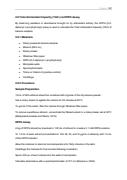P a g e | 17 2.5 Total Antioxidant Capacity (TAC) via DPPH Assay By observing variations in absorbance brought on by antioxidant activity, the DPPH (2,2- diphenyl-1-picrylhydrazyl) assay is used to calculate the Total Antioxidant Capacity (TAC) of banana samples. 2.5.1 Materials •Dried, powdered banana samples •Ethanol (96% v/v) •Rotary shaker •Whatman filter paper •DPPH (2,2-diphenyl-1-picrylhydrazyl) •Microplate wells •Spectrophotometer •Trolox or Vitamin E (positive control) •Centrifuge 2.5.2 Procedure Sample Preparation 12 mL of 96% ethanol should be combined with 4 grams of the dry banana powder. Use a rotary shaker to agitate the mixture for 45 minutes at 65°C. To get rid of the solids, filter the mixture through Whatman filter paper. To remove superfluous ethanol, concentrate the filtered extract in a rotary shaker set at 50°C (Martysiak-Zurowska and Wenta, 2012). DPPH Assay 4 mg of DPPH should be dissolved in 100 mL of ethanol to create a 0.1 mM DPPH solution. To 1.5 mL of each extract (concentrations: 100, 50, 25, and 10 μg/mL in ethanol), add 1.5 mL of this DPPH solution. Allow the mixtures to stand at room temperature for thirty minutes in the dark. Centrifuge the mixtures for five minutes following incubation. Spoon 200 µL of each mixture into the wells of microplates. Calculate absorbance with a spectrophotometer at 517 nm (Molyneux, 2004).
